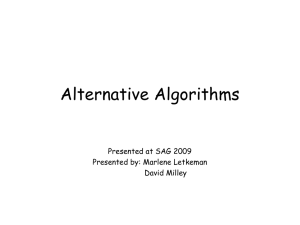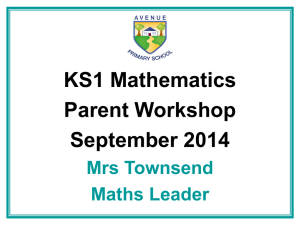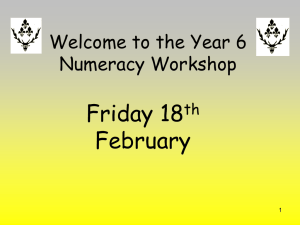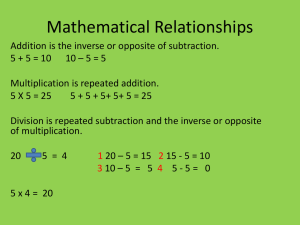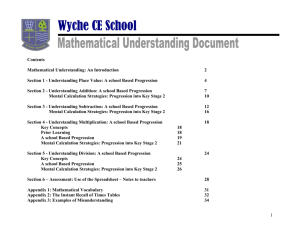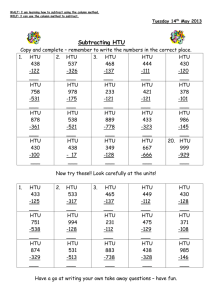maths workshop - four operations
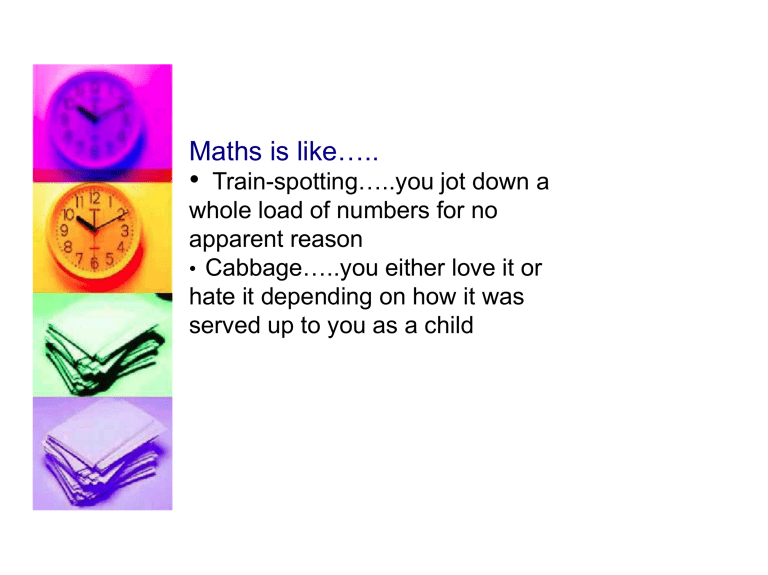
Maths is like…..
•
Trainspotting…..you jot down a whole load of numbers for no
• apparent reason
Cabbage…..you either love it or hate it depending on how it was served up to you as a child
Aims of session
•
To work through each of the methods we teach at Rushen Primary for addition, subtraction, multiplication and division.
WHY?
•
We want children to develop efficient methods of calculations with addition, subtraction, multiplication and division.
•
We want children to be able to choose an appropriate method for their calculations.
•
We want children to develop a mathematical understanding, a feel for number not just a mechanical method that is prone to error.
• We want to develop “learners for life”.
Language of addition.
Addition
Sum altogether
More
Add
Make
Plus
Total
• Methods of addition.
Starting with knowing number bonds, use of apparatus, adding groups of apparatus together.
•
4 + 2 = 6 1 + 1 + 1
+ + +
•
Working across the line adding significant digits first ie in 14 +
15, add the tens first and then the units.
Need to have sound place value understanding before doing sums like 16 +
18 where digits cross the tens boundary.
Methods of addition.
•
Column addition. Digits with the same value must be lined up underneath each other. Once concept of adding units first then tens is understood then can work on where to put digits when values break the tens boundary.
Language of subtraction.
Take away Difference
Subtract
Leave
Minus
Less
Methods of subtraction.
•
Starting with knowing number bonds, use of apparatus, taking groups of apparatus away from a total - how many are left.
•
4 - 2 = 2
Methods of subtraction.
•
Working across the line subtracting significant digits first ie in 39 - 15, subtract the tens first and then the units. Need to have sound place value understanding before doing sums like 34 - 18 where digits cross the tens boundary. Use of number lines to show jumping or counting on in stages.
Methods of subtraction.
•
Column subtraction. Digits with the same value must be lined up underneath each other. Once concept of adding units first then tens is understood then can work on what to do to when a subtraction can’t be done - borrowing from the next column.
Language of Multiplication.
Multiplication
Array lots of
Groups of
Times
Multiply
Repeated addition
Multiple of
Multiplied by
Multiplication facts - what are they?
•
Yr 4 - Know all multiplication facts to 10 x 10 and division facts.
•
Multiplication facts are the times tables where two numbers are multiplied. Children are expected to be able to recall and make use of multiplication facts up to 10 x 10 by end of Yr5. They are key to many areas of maths not just multiplication and division.
•
Yr 5&6 Using multiplication and division facts.
Ideas for revising and applying multiplication facts.
•
Reciting times table facts ie 1x4 is 4, 2x
4 is 8 etc.
•
Round the clock
•
Shopping
•
Using playing cards
•
Board games
Methods of multiplication HTU by U
Important
•
Multiplying, product, units, tens, hundreds, multiple, array, lots of, times, multiply, double.
•
Refer to each number by its correct value - ie 5 or
40 or 300.
Grid Method
Formal Method
126 x 3
126 x 3
Methods of multiplication
HTU by TU
Grid Method
24 x 16
Formal Method
24 x 16
Language of Division.
Share Equal groups of
Divided by
Share equally
Divide
Divided into
Methods of Division HTU by U
•
Words linked to division - group, divide, division, divided by, divisible, factor, share, half, remainder.
•
Need to know division facts - related to times tables knowledge.
Formal method
196 ÷ 6
Methods of dividing
HTU by TU
Repeated subtraction
972 ÷ 36
Formal method
972 ÷ 36



